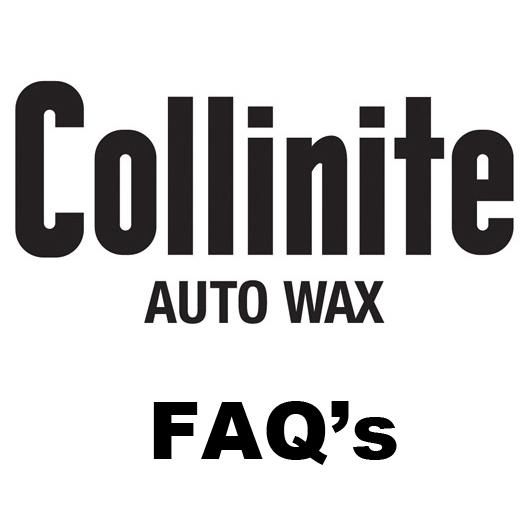Collinite FAQ - What's what?
1. What’s the difference between the Fleetwaxes-No. 870 and No. 885?
The No. 870 is a liquid cleaner + wax combination designed for use on slightly soiled or contaminated fiberglass and RV surfaces. Its dual function removes embedded contaminants while leaving behind a high gloss shine and light protective wax coating. The No. 885 is a hard paste formula with no cleaners, abrasives or restorative properties. The No.885 offers superior shine while leaving behind Collinite’s longest-lasting marine weather protection.
2. What’s the difference between the auto waxes; No. 845 Insulator Wax, No. 476s Super Double Coat and the No. 915 Marque D’ Elegance?
All 3 last step waxes serve the same function: to provide a high gloss carnauba shine and lasting protection. All 3 contain copious amounts of wax-both rare Brazilian carnauba and premium synthetic polymers. However, their degree of durability, ease of use, and warmth of shine vary. Think of it this way;
1. No.476s – most durable protection/weather defense. Most elbow grease required during application.
2. No. 915- 2nd most durable and slightly easier than the 476s to apply/remove. No. 915 lends our warmest shine to dark tones like navy and black due to its highest concentration of rare carnauba.
3. No. 845- easiest of the 3 to apply/remove with slightly less durability than the No. 915.
3. What’s the best wax process for the fiberglass/gel coat on my boat?
This is a loaded question and depends on a few factors-surface condition of your boat, amount of work you’re prepared to undertake, what caliber of durability/longevity you’re looking for.
“My boat is slightly oxidized/weathered (needs more than just a wash) and I want the longest-lasting protection. I’ll do any kind of work neccessary.”
Wash. 920 Fiberglass Cleaner. No. 885 Fleetwax Paste. (Skip pre-waxing with No. 920 if surface is free of embedded contaminants)
“My boat is slightly oxidized/weathered (needs more than just a wash) I want a very strong degree of wax protection, but I don’t want the elbow grease of using a hard paste wax.”
Wash. 920 Fiberglass Cleaner. No. 925 Fiberglass Boat Wax. (Skip pre-waxing with No. 920 if surface is free of embedded contaminants)
“My boat is slightly oxidized/weathered (needs more than just a wash) and I want a reliable coat of wax protection to last a few months. Because I’m in a hurry to get it in the water, I don’t want to do a 2 step process.”
Wash. No. 870 Liquid Fleetwax (cleaner-wax combination).
4. Can Collinite Last Step Products (LSP’s) be used in conjunction with an alternative brand sealant?
Between producing, pouring and shipping, we’ve yet to conduct testing with all the sealants out there (too lengthy to list), so this practice cannot be formally recommended. However, sealant + Collinite LSP layering is a common method among Collinite aficionados. Call us with specific questions or check out reliable online forums with inquiries.
5. Do new and used cars/boats require different waxes?
Don’t lose sleep over the age of the car/boat. Instead, take into account the surface condition. Does it appear like-new, or is there embedded contamination; fading/discoloration, swirls, noticeable weathering? On like-new, contaminant-free surfaces (following a wash), use one of Collinite’s LSP’s (845, 476s, 915, 885 or 925) For weathered or contaminated surfaces, (following a wash) first use pre-wax products to restore the luster, clarity, color etc. Then follow up with a Collinite LSP. *Collinite does NOT currently manufacture pre-wax products for darker toned clear coats.
6. Are any Collinite products recommended on exterior glass, rubber, vinyl, plastic, metal?
Glass, Rubber, Exterior Vinyl/Plastic trim-NO
Metal-YES (No. 850 for coated and non coated aluminum, stainless steel, chrome, brass and copper) *No. 850 is NOT intended for painted metals.
7. What products are recommended for RV?
Follow same basic guidelines as FAQ #3
8. Can Collinite auto waxes be layered?
The durability of Collinite waxes means layering is not always necessary, but it continues to be a common practice among Collinite users who prefer extra-thorough coverage. Call us with specific questions about cure times in between applications.
9. Do prep products like cleaners, polishes, clays or compounds need to be used before applying one of your last step products (476/915/845/885/925)?
Pre-waxing is not always necessary, but many Colliniters find that meticulous prep work improves clarity, wax coverage and bond. If surface requires the removal of swirls, scratches, discoloration/fading, water spots, or other embedded contaminants be sure to pre-wax. However if surface is thoroughly clean and like-new following a wash, apply the wax.
10. Which of your auto waxes provides the best shine? Longest protection?
For darker colors (black or navy blue) No. 915 provides the warmest, high gloss carnauba shine.
Longest protection-No.476s
10. Which of your marine waxes provides the best shine? Longest protection?
Best shine/longest protection-No.885
11. Are the No. 845 and No. 925 supposed to be thick/hard like a paste, or thin like a liquid?
The viscosity of the 845/925 is certainly thicker than many liquid versions of a paste wax. Simply put, there is a lot of wax in each bottle which makes it thicker. Also, we added more carnauba to the formula a few years back to prevent product separation, and improve gloss/durability.
The 845/925 now discharges from the bottle more like toothpaste than liquid because its higher concentration of wax. The application, spread and ease of use are the same as in the past. If making the product more liquid-like is desired, we recommend submerging the bottle (capped) in a warm-hot pot of water for 5 minutes. Remove and shake the bottle vigorously with your thumb tightly on the cap for one full minute. The added heat and friction from shaking will warm the bottle’s contents and the creamy liquid consistency will be formed. In the colder months of the year, the thicker 845/925 is now the norm if not altered by the aforementioned method.
12. Can Collinite Marine waxes be used on non-skid marine surfaces?
Our waxes make virtually any surface slippery. So for safety reasons, Collinite Marine Waxes are not recommended for non-skid surfaces. The 920 Fiberglass Boat Cleaner can be used in order to wipe away and clean contaminants in the grooves, but it will not offer any weather protection.
13. What kind of spread can I expect from your waxes? In other words, how much of your product will I need for the job I’m doing?
It is essential to remember that all Collinite waxes should be applied in extremely thin layers and in small sections in order to achieve long lasting results. On average, a can of paste wax will cover more area than a liquid-gel wax. However, a liquid-gel’s spread will seem smoother and easier than a paste because it is softer.
14. What are the drying times of your products?
Drying times depend not only on the air temperature but the surface temperature as well.
If the surface is hot to the touch, the wax will require a longer time to dry and will not properly bond to the surface if removed prematurely. Early removal will result in moving the wax around with the cloth or “smearing” the surface. Waxing a hot surface, especially in direct sunlight, is not recommended.
If the surface is cold to the touch, the wax may dry too quickly. Removal may prove be difficult and traces of wax could remain embedded in the surface. This is more commonly known as “streaking”. A cold surface is also not recommended.
The ideal surface temperature is lukewarm to the touch or as close to room temperature as possible. This will allow for the wax to dry at its normal time which is around 1 minute for a cleaner-wax, 2-3 minutes for a liquid-gel wax, and 3-4 minutes for a paste (on average). Of course these times will vary based on wind, humidity, heat exposure and detailing expertise. As soon as the wax has shown a pigment or cloudiness after being applied, this means it is drying or “hazing.” While some professional detailers allow for longer cure times, the hazing phase is a novice’s basic cue for removal.
We recommend waxing at air temperatures between 55 degrees-80 degrees F whenever possible. However, surface temperature takes precedence over air temperature.
15. Why don’t Collinite bottles have squirt tops?
Hand pouring our products also means hand-capping them (we know it’s old fashioned). The screw tops are first and foremost a safety precaution. We are currently not equipped for seals on tops of the bottles, and therefore use the screw tops because they are child proof. We apologize for this inconvenience.
16. How do I order Collinite Industrial/Electrical Maintenance products?
Please call or email Collinite DIRECTLY to order Industrial/Electrical Products. These items are non-stock for distributors.
17. Which of your products are clear coat safe?
Absolutely clear coat safe: 845, 925, 476s, 885, 915
Only recommended for light clear coats (white, silver, tan): 840, 920, ss126, 870
18. What is the shelf life of your products?
Collinite pure waxes have a long shelf life (sometimes up to 5 years). The polishes and cleaners such as 920, 850 and 870 will last for 2-3 years on average. All products should avoid exposure to frozen temperatures.
19. Are your products safe to use with a machine buffer?
Collinite’s products are safe to be used with a variety of machine apparatus. However, we do not recommend using a buffer unless you are already proficient with one; having been trained or used the machine extensively with different products and surfaces. Always refer to machine’s recommendations (pads, speeds etc) when using it with Collinite. Professional results can be easily obtained by using Collinite by hand.




















